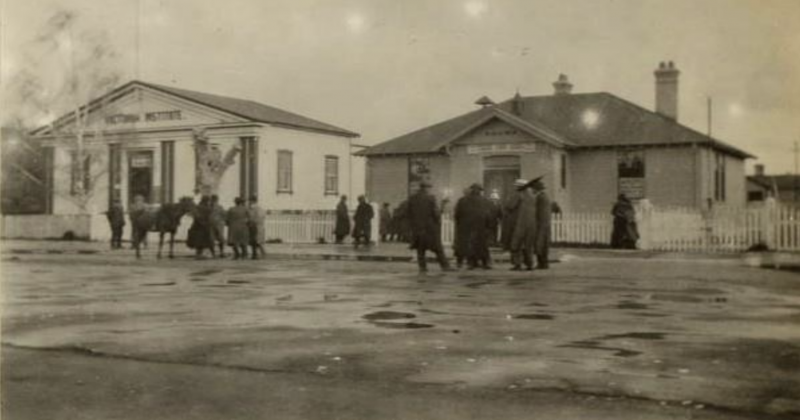Our School History
The first school in the Rotorua District was a Native School. Established under the Native Schools Act of 1867, it was opened at Ohinemutu in March, 1868, with 49 pupils, but only operated for a few years.
The first State, or Department of Education,school to be established in Rotorua was the Rotorua Public School. It opened in October, 1886, and it first started in the Comet Store on Lake Road with 36 pupils. It is the oldest school in Rotorua, and is today known as Rotorua Primary School. It would not be for another 28 years that secondary education was introduced in Rotorua.

This occurred on 8 June, 1914, when a Secondary Department was added to the Rotorua Public School and it then officially became the Rotorua District High School for Years 1 to 13 or ages 5 to 17. Its Secondary Department, which later became the Rotorua High School, commenced with 21 Foundation Pupils – eleven boys and ten girls – and it first started in the Victoria Institute on Arawa Street. It is with the Secondary Department that Rotorua Boys’ High School dates its establishment from.
The mid-1910s, during World War I, were a time of pioneering development for the School. The earliest of its traditions were established, and its first inter-school connection with the Tauranga District High School started in 1915. The School lost one staff member and one Old Boy in World War I, and the second Principal took leave of absence to serve in the war.

The 1920s were a crucial decade in the School’s development. This first-half of this decade saw the School steadily grow and move three times as the roll increased. In early 1924, a permanent site on Pukuatua Street was selected for the School, but it would not be for another four years that it would move to there. In the meantime, it was moved in August, 1924, from the Victoria Institute to the Young Men’s Christian Association (YMCA) on Pukeroa Hill. 1927 saw the School attain full State high school status. It then became the Rotorua High School for Years 9 to 13, and the Rotorua Junior High School for Years 7 and 8. Pending the construction of the new school building on Pukuatua Street during 1927, the School was moved from the YMCA building into King George V Hospital (now Rotorua Public Hospital) for the 1927 school year. The original Rotorua High School building (now A Block) was completed early in the New Year of 1928, and the School was officially re-opened on the present site by the Minister of Education, the Hon. R.A. Wright, on 9 February.
The 1930s was a decade of steady growth, consolidation, and new development.
The first-half of the 1940s was marked by World War II. Over 500 Old Pupils served our country in the war, 63 Old Boys and one staff member were killed in the war, and seventeen Old Boys were decorated for their heroic actions. The War Memorial Hall, which was built in 1959, serves as the School’s memorial to its War Dead.
After World War II, the roll grew rapidly as a result of the post-war “Baby Boom” and by the early 1950s there were 1,250 pupils – the highest roll in its history until the mid-2020s. No permanent new classrooms were approved by the Department of Education to accommodate the roll growth and this caused serious accommodation issues. The Government decided to address this problem, as it did for many other high schools in New Zealand in the 1950s, by separating groups of pupils to form new schools of their own. The first to leave were the intermediate pupils at the end of 1956, and the girls left at the end of 1958. That left 582 boys to form Rotorua Boys’ High School from the start of 1959.
The 1960s saw the School’s first overseas sports tour to Australia, and military training end in 1969.
In the 1970s, the innovative and ground-breaking “Levels System” of academic streaming was developed and implemented. The first computers arrived, and the School played the leading role in the development of a full tertiary education institution for Rotorua with its establishment of a Technical Institute Division in 1972.
During the 1980s all of the School’s permanent buildings were upgraded and refurbished. Computers were expanded and updated, and a modified system of academic streaming with three “Bands” was implemented to replace the Levels System. The major change, however, came at the end of this decade with the transformation of the entire New Zealand education system under the “Tomorrow’s Schools” and “Learning for Life” educational reforms of 1989.
In the 1990s, bi-lingual and accelerate classes were introduced (the teaching of Te Reo Māori had first started in the School in 1953). The Hall of Fame Ngā Raukura I Te Ao was established in 1993, Te Whare-O-Raukura was opened in 1994, and off-site hostel boarding commenced that year. The first international pupils began to arrive in greater numbers, and significant national-level sports achievements were made. In 1998, the very successful “Super 8 Schools” Competition of Boys’ High Schools in the North Island was developed and launched by the School.
In 2000, the start of the new millennium was marked by the Golf Team becoming the World Secondary Schools’ Champions, and the Millennium Centre and a second off-site boarding hostel were opened. The First XV won the World Secondary Schools’ Rugby Championship in 2003, and they successfully defended that title for 2004. Many new innovations based on the traditional boys’ school model – with a particular focus on lifting achievement for our Māori boys – were also made. The School also fully embraced during the 2000s all new digital technologies and resources for e-learning and education. In 2005, the Tai Mitchell Hostel was built and the two separate off-site hostels were together at the School.
The 2010s saw more advances made in digital learning and further sporting and cultural successes achieved at the national-level. In 2015, the School officially moved the date of its establishment from 1927 back to 1914 with the opening of the Rotorua District High School. In 2019, in recognition of the work of its Tai Mitchell Hostel, the School won the Prime Minister’s Excellence in Leading Award and the Prime Minister’s Excellence in Teaching and Learning Award and also the Prime Minister’s Supreme Award. These three prestigious awards confirmed the School as being one of the leading high schools in New Zealand.
In 2020, the School was identified as being one of the most innovative schools in the world in terms of its use and application of digital learning technology in the classroom. It became, that year, the first State high school in New Zealand to be awarded with “Apple Distinguished School” status by the Apple Computing Company in the United States. Early 2020 also saw the COVID-19 pandemic and, along with many other countries, New Zealand move into “lockdown” for some months. As a result of its already long-established and highly advanced work in digital learning, the School was able to move swiftly to online-only learning for much of 2020. In response to the “Black Lives Matter” movement, which also started in early 2020, the School changed the names of its four Houses for the first time in 93 years. Originally named after famous Englishmen in 1927, they were changed to locally-inspired and more relevant Māori ones. At the end of 2023, the long planned for and much-anticipated $10 million Pūtaiao (Science) Centre was opened.
In mid-2024, following the retirement of Mr. Chris Grinter, M.N.Z.M., the School's longest-serving Principal since 1914, the Board of Trustees made a new appointment for the first time in 33 years. At the start of 2025, former Head Prefect and Director of Māori Achievement at Rotorua Boys' High School, and most recently the Principal/Tumuaki of Marlborough Boys' College since 2021, Matua John Kendal commenced at his old school as the twelfth, and the first Old Boy and also the first Māori, Principal/Tumuaki.










